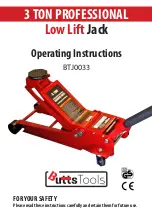
16
Check the surroundings of the
plane, remove any obstructions,
and the wheel chocks. The
throttle is also the directional
control (PUSH/PULL), then twist
the throttle to start moving. Make
sure you familiarize yourself with
how long it takes for your plane
to ramp up/down and stop. That
“coast” when slowing is due to
the software that protects your
nose gear from unnecessary
damage and stress; take the time
to get used to this feature and be
aware as you move your aircraft.
We strongly recommend moving
your tug without aircraft attached
to get used to the controls and
movements. As you are moving
your plane, be sure your nose
gear can handle the turns you
are taking. As the operator, you
are responsible for knowing the
limitations of your specific aircraft.
Moving Your Plane
Tips, Tricks, and Warnings
Always use wheel chocks
when loading and unload-
ing your plane.
CAUTION
The winch handle rotates quickly
as your plane unloads from the tug,
keep hands clear (FIG 15)
Leave the slack left from unloading
the plane unspooled; this leaves
the attachment/strap ready to be
attached for your next flight.
Anchor your hand against the control
tower and move the throttle with your
thumb. In effect, you’re cuddling the
throttle under your thumb, not just
the tip; this assists in minimizing any
jerkiness. Switching to low is strongly
suggested when working in tight
spaces.
Always turn off the master
switch when charging.
Common Error Codes
50: Under Voltage
52: Under temperature
53 Over Temperature
90: Motor Over Temp Cutback
95: Controller Under Temp
96: Stall Detected
97: Controller Over Temp
99: Undervoltage Cutback
102: User pressed the E-Stop
Summary of Contents for Echo 12
Page 1: ...Echo USER MANUAL 12 18 Best Tugs Because Your Plane Deserves It ...
Page 2: ......
Page 5: ...5 ...





































